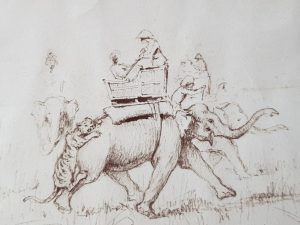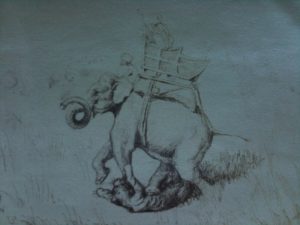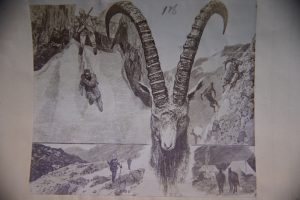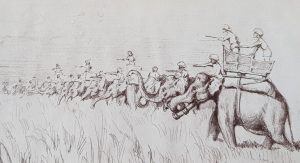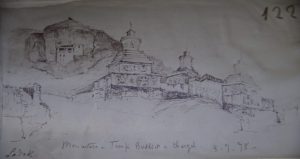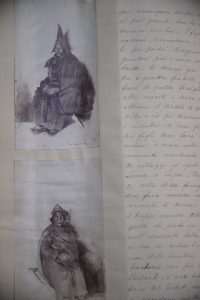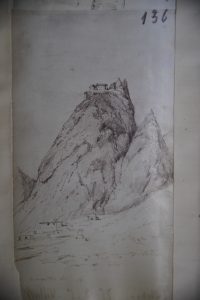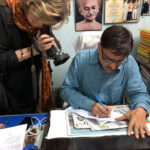Our History
Indoroman is the result of research on the textile heritage, between the Mediterranean and India.
INDOROMAN
Gaia Ceriana Franchetti was born in Buonconvento (Siena) and graduated in Philosophy at the La Sapienza University of Rome
From 1975 to 1978 she travelled extensively in India for the making of her first documentary "Ladakh center of steps". During these first trips to India, she discovers and appreciates handloom fabrics.
In 1985 with the Italy India Association of which she was the President until 1993, she curated the exhibition dedicated to Leonardo da Vinci in India in 1986. In 1991 she published "The mirror of the Prince: The Medici and the Mughals" (Edizioni dell'Elefante, Rome).
In 1995 she founded Indoroman to collect and utilize fabrics still produced on a manual loom, between the Mediterranean and India: a textile heritage to be defended and diffused.
India & Italy ancient relations and trade
Soft Powers established our earliest relations in history and Similarities indeed have created our long-lasting relationship. According to Professor Alain Danielou, in his History of India, in very ancient times there was some kind of a common stage of civilisation, made of state cities, trade, movement of people, spreading from India into the Mediterranean, there were shared values activities and ways of life, among the differences. Our ancient languages Sanskrit and Latin also reveal these interactions. One of our main Poets, a man of great knowledge, a philologist who also studied Sanskrit, Giacomo Leopardi, states that relations between India and Latium (the region of Rome) existed in pre Etruscan times. During Roman imperial times there was a trade with India, a lot of it especially with the south, Roman coins, still found today, so many of them, shows it very clearly. Among other goods the Romans imported from India, there was cotton, probably the light Mul Mul, the famous muslin from Machilipatnam, because they called it the fabric of wind. The Romans wove mainly heavy wool, that certainly doesn’t fly with wind.
Then came the scholars sent by the Church, the Jesuits at Akbar’s court and Roberto de Nobili, the Brahmin from Rome, as he was called in Madurai, who was able to speak so many languages of the south to spell God, but became a Hindu in his way of life and dressing and underwent an inquisition by the Church of Rome. They didn’t burn him because he was a priest and the nephew of a cardinal. He remained and died in India. The aesthetics, the quest for beauty of shapes and materials, the marbles, techniques and skills, the need for decoration, also connected India and Italy. From the Renaissance with The Mogul-Medici connection and continuing into our days with technology, cinema, music, the arts and literature. In Italian history also textiles have been crucial, colours originally created for textiles nourished the use and sense of colours in paintings from Giotto time onwards. Manufacture and trade of textiles were major productive activities. Up to recent time wool from Piemonte and silk from Lombardia, are still of the highest quality and world renowned. Italy was also the largest producer of hemp till 1950, when plastic came in to use.
As for me what hooked me to India has to do with some kind of practical knowledge, the need for it and India gives plenty. The range is wide: from how to perform a rite, or recite a mantra, how to breathe, how to use a splendid brocade, or how to try and fix everything, how to wash an elephant and how to wash yourself, how to use cow dung to make a decorated sculpture for surrounding your house and then use it for cooking, how to sit on your legs, how to drink from a bottle without touching it with your lips. And on top of everything else the amount of unconventional, almost unreal conversations that can naturally touch a variety of topics, you can have even with people you just meet on the road. For all I learned from India I consider myself an Indoroman as it is extremely natural to melt the common elements into this form. This house/factory restored with Giorgio Franchetti my husband, who was naturally inclined towards roman aesthetics, as I was for indian, was often described as giving an Indoroman impression. So my textile company bears the same name. Our two countries are irradiating culture around them and as poles of civilisation they should keep on doing this with the best regard and consideration for each other and their similarities.
Journal of a Journey 1877-79
Manuscript of a journey to India by Giulio Grazioli Lante della Rovere great grandfather of Gaia.
The purpose of the hunt was one of the causes that led us there: but it was precisely for this reason that we had the opportunity to see very different places and things, and which perhaps with another purpose we would never have known or seen.
Giulio Grazioli Lante della Rovere, Short memories of a trip to the mountains of Kashmir, Turin, Candeletti, 1881
Biofilmography by Gaia Ceriana Franchetti
She has made the following film documentaries:
"Ladakh center of passes" 90 '(1978), 2 episodes on Tibetan Buddhism and the city of Leh.
RAIUNO
(awarded in San Sebastian 1978 and Granpremio Mifed Guglielmo Marconi best TV product 1979)
"The chrysalises" 4 episodes of 52 'on the Islamic women of the Maghreb. 1981 RAIDUE
“Video travel diary with letter” a journey through USA. Caribbean and Brazil between friendship and love. 1983. Salsomaggiore Festival.
“Now that we are no longer children” 1991-96. Eight contemporary artists work, each for a day with the children of a public school in Rome. Siena Santa Maria della Scala 1999 "Madre" Museum Naples 2001
"Xinjiang Knot of Asia" 2001, created for La Sapienza University, 'Dep. Oriental Studies. Audience Award at the Asian Film Festival in Rome Nov. 2005.
“Textile Safari” 2005 a journey in search of the handcrafted textile varieties of Gujarat and Rajasthan.
'Iaco's Tale', 2009, a docufiction on the story of Tenzin Sherap, a Himalayan child, who can see the cosmos. AsiaFilmmediale Festival Rome 2009. Aljazira Asia 2010
"An Italian Artist in India". Portrait of Simona Bocchi. Sculptress. Italian Cultural Institute New Delhi 2012
'Tapidoo' Gaia and Pietroarco Franchetti, her son. Portrait of Giorgio Franchetti collector of Contemporary Art Venice Ca'd’Oro Exhibition From Giorgio to Giorgio 2014 Macro Museum Rome 2016.
"E’pèn dé mond" mosaic-film about Romagna. Portrait of a lively region through characters, history and productive activities. 2017 Cesenatico Maritime Museum, April 2018
'The wheel of Khadi: The warp and weft of India' 70m. January 2019. Selection of Rome Film Fest October 2019. River to River Film Festival Florence January 2021.
I NOSTRI TESSUTI
Khadi Silk Cotton
SHOWROOM
Come and visit us in the shop

